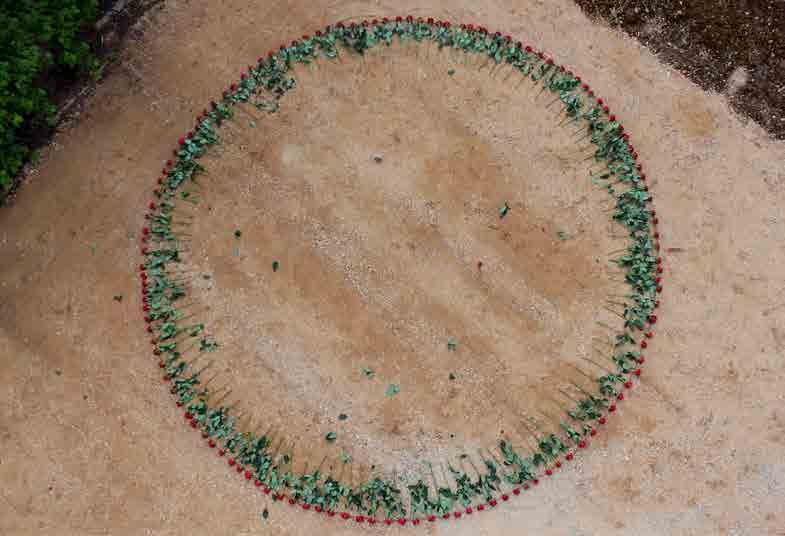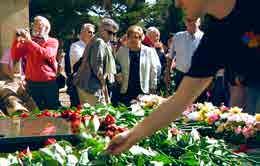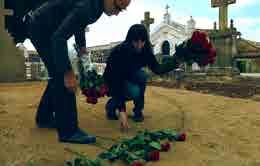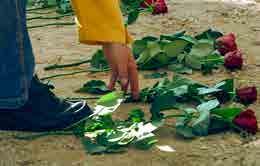
3 minute read
AMAIA MOLINET
(Lodosa, 1988) http://www.amaiamolinet.com
Amaia Molinet (1988) is an artist native from Lodosa (Navarra) and she lives and works in Bilbao and Cluj-Napoca. She holds a Master in Contemporary, Technological and Performative Art and a Bachelor in Fine Arts from the UPV / EHU. She develops her artistic practice from an expanded photography, addressing the relationship between territory and identity, and highlighting landscape’s symbolic features. She has been awarded grants and prizes by organizations such as the Guggenheim Museum, INJUVE, Eremuak, C arte C, Centro Huarte or BilbaoArte Foundation and she has carried out artistic residency stays in Artifariti (Western Sahara), SÍM House (Reykjavík), Nau Estruch (Sabadell, Barcelona), Zébra3 – Fabrique Pola (Bordeaux) Fabrica de Pensule and Centrul de Interes (Cluj-Napoca). She has had individual exhibitions such as “The Earth may want to be like it was before existing” in Hiriartea (Ciudadela de Pamplona), “Das Paradies” at La Taller Gallery (Bilbao), “Future Fossils” at the Archaeological Museum of Bilbao and Centro Cultural San Martín (Buenos Aires) and “Mugak” in BilbaoArte Fundazioa. Her work has been shown in group exhibitions in contexts such as the Huarte Contemporary Art Centre, Sala Rekalde (Bilbao), Montehermoso Cultural Centre (Vitoria-Gasteiz), San Telmo Museum (Donostia), Fabra i Coats Centre d’Art Contemporani (Barcelona), or Rafael Pérez Hernando Gallery (Madrid), among others.
Advertisement
Amaia Molinet (1988) née à Lodosa (Navarre) travaille et vit à Bilbao et ClujNapoca. Elle est titulaire d’une maîtrise en art contemporain, technologique et performatif et Diplôme d’arts plastiques dans l’UPV/EHU.Elle développe sa pratique artistique à partir d’une photographie élargie, abordant la relation entre territoire et identité, et valorisant les traits symboliques du paysage. Elle a reçu des bourses et des prix d’organisations telles que le Musée Guggenheim, INJUVE, Eremuak, C arte C, Centro Huarte ou BilbaoArte Fundazioa, et a effectué des séjours de résidence artistique à Artifariti (Sahara occidental), SÍM House (Reykjavík), Nau Estruch (Sabadell, Barcelone), Zébra3 – Fabrique Pola (Bordeaux) Pensule Factory et Centre d’Intérêt (Cluj-Napoca). Elle a réalisé des expositions individuelles dans des espaces tels que La Terre pourrait vouloir être comme avant d’exister à l’Interurbano (Ciudadela de Pamplona), à la Galerie La Taller (Bilbao), au Musée Archéologique des Futurs Fossiles de Bilbao et au Musée Culturel Centre San Martín (Buenos Aires) et à la Fondation Bilbaoarte Mugak. Il a également participé à des expositions collectives telles que le Huarte Contemporary Art Center, Rekalde Hall (Bilbao), Montehermoso Cultural Center (Vitoria-Gasteiz), San Telmo Museum (San Sebastián), Fabra i Coats Center d ‘Art Contemporani (Barcelone) ou la Galerie Rafael Pérez Hernando (Madrid).




‘131’. 2013. Video. Photographic print on a 225x150 cm piece of fabric. 2013.
On 22 June 2013, an event was held in the Lodosa town cemetery to pay tribute to those who died during the Spanish Civil War and who, some years previously, had been commemorated by the building of a vault in which they were given honourable burial. To mark the occasion, the artist Amaia Molinet created a circle of 131 roses, each of which represented one of those who lost their lives. The circle surrounded an enormous empty space symbolising the silence that had been imposed on their memory for so many years. As the names of the dead were read out, their families picked up the roses, one by one, and placed them in the vault that now houses their remains. The hope was that this performative act would give the victims’ families some degree of closure, putting an end to the pain and silence in which they had existed for so many years.


‘131’. 2013. Vidéo. Impression photographique sur toile 225x150 cm. 2013.
Le 22 juin 2013, fut célébré au cimetière de Lodosa un hommage aux morts dans la guerre civile qui avaient été commémorés quelques années plus tôt par le biais d’un panthéon où on leur donna une sépulture digne. L’artiste Amaia Molinet créa pour l’occasion un cercle avec 131 roses représentant chacun des morts, cercle qui contenait un énorme vide intérieur symbolisant le silence dans lequel était tombée leur mémoire pendant tant d’années. Peu à peu et répondant aux noms des morts, les proches ramassèrent les roses une par une et la déposèrent au panthéon qui conservait leurs dépouilles. L’action performative put aider à mettre fin à une étape de douleur et de silence que les proches des victimes avaient vécue pendant de longues années.









